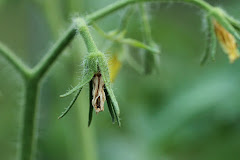 It looks like the time to plant warm season vegetables without temperature modifiers (water walls, etc.) is finally here. Starting June 1, the forecast is for nights to consistently attain 50 degrees F and days to be in the 80's and even 90 degrees F. With the warm nights, tomatoes, peppers, eggplant and the rest of the vegetables mentioned last post will now prosper when planted.
It looks like the time to plant warm season vegetables without temperature modifiers (water walls, etc.) is finally here. Starting June 1, the forecast is for nights to consistently attain 50 degrees F and days to be in the 80's and even 90 degrees F. With the warm nights, tomatoes, peppers, eggplant and the rest of the vegetables mentioned last post will now prosper when planted. This also means the end of cool season vegetables like the lettuce and bolting rapini (broccoli raab) pictured above. It's time for these to go into the compost as they are now most likely bitter or fibrous. Rapini in bloom does make a good bee plant if you want to encourage bees or are keeping bees. In tnat case you can wait until after flowering to pull plants.
This also means the end of cool season vegetables like the lettuce and bolting rapini (broccoli raab) pictured above. It's time for these to go into the compost as they are now most likely bitter or fibrous. Rapini in bloom does make a good bee plant if you want to encourage bees or are keeping bees. In tnat case you can wait until after flowering to pull plants.
Direct seed plants from a different plant family such as squash, beets and carrots or plant warm season transplants in place of the rapini.
Photo credit: Cool season vegetables gone by, Rapini blossoms - both Carl Wilson





